The Brooklyn Museum of Death
by Emma Whitford
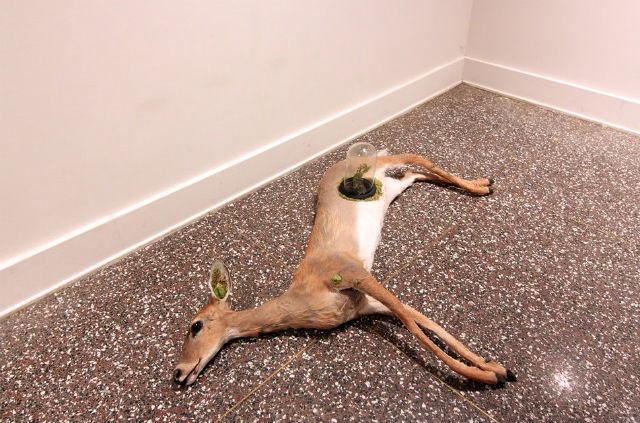
I attended my first rat class on a Sunday afternoon in January. The snow melted overnight, but by morning it had refrozen into black ice, which made the walk between the 4th Avenue-9th Street stop and the future Morbid Anatomy Museum, located in a vacant, pre-renovation nightclub in industrial Gowanus, extremely terrifying. This probably explains why most of the registered students bailed at the last minute, even after paying $185 for a dead rat, scalpel, access to a box of accessories fit for Barbie and expert instruction.
When I arrived, Katie Innamorato, the teacher, was wearing a polyester wolf jumpsuit with pointy ears, a row of white fangs, and a lolling red fabric tongue. She was arranging the rats on a folding table as if setting up a child’s birthday party. The rats, bright white and all the same size, were “feeders,” or mass-market snake snacks. After the three other students who braved the elements — a bearded deer hunter from upstate, his amulet-necklaced wife, and a teenager in a hoodie whose mom dropped her off with lunch money — were settled in, Katie started instructing: massage some warmth into the rat’s limbs, then place its belly flat against the table, and part its fur along the spine.
As a member of the Minnesota Association of Rogue Taxidermists, Katie would never cut into an animal that wasn’t hit by a truck, dead from natural causes, or donated by a feeder farm. (She recently owned a wild fox as a pet, though it now resides at the Staten Island Zoo.) The Rogues, as they call themselves, number some 40 working members, and have enough followers these days — Katie has nearly 3,800 on Instagram — that she has been able to support herself by teaching all over the country and making her own specimens (they’re into mutations and chimeras, like two-headed kittens and squirrels with partridge wings).
Katie, who is 24, has always been interested in dead animals. “In high school, I started picking up really disgusting road kill off of the side of the road and burying it in my back yard, to clean the bones,” she said. “I’d dig them up months later, whiten them, and sell them online.” Four years ago, she found a mentor in Sussex, New Jersey — a traditional taxidermist (think lodge-style deer mounts) who was willing to share his expertise with a novice. Katie brought her skills to college at SUNY New Paltz, where her 2012 fine-arts thesis exhibition featured an open-eyed doe lying on its side, moss sprouting from her ears, and a transparent dome attached to a hole in her side that allowed the viewer to peer, glass-bottom-boat-style, into her belly. Her inspiration was two-fold: cannulated cows, which have viewing windows in their stomachs, for science, and Joel-Peter Witkin’s “Cornucopia Dog,” a photograph of a dead dog with a Thanksgiving cornucopia spilling out of it. “I was like, ‘Oh shit! This is the perfect way for me to incorporate living things into these dead animals!’” Squint, and her work is hardly morbid. “It’s about remembrance — a way for me to memorialize my subjects.”
Sitting in a folding chair by the nightclub’s former bar, my stomach had long since turned. The initial scalpel incisions were gory — white fur split open to reveal a bright red sliver of glistening viscera — but the guts themselves are surprisingly neat and contained, like little pink balloons. And with the exception of one infected liver (the hunter’s wife, after holding a poker face for nearly an hour, had to run to the bathroom), the class fell into a rhythm.
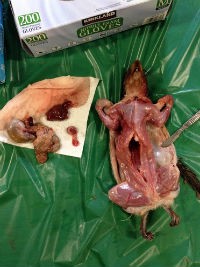

Joanna Ebenstein founded the Morbid Anatomy Library in 2009 as a companion to her blog of the same name. The tiny, overflowing research library and private collection (the forthcoming full-fledged museum is a logical next step) is dedicated to more than just taxidermy (think Korean Koptu dolls to guide you through the afterlife, and 17th century commemorative hair jewelry). But Joanna, an artist, curator, writer and historian who has always loved animals and been fascinated with death, has a more cohesive mission: to explore, through exhibitions, classes,and lectures (Wet-Specimen Preservation, The History of Bodysnatching), macabre artifacts that would otherwise fall through the cracks.
Last year, Joanna spent six months in London, tracking down a rare collection of tableaux by Walter Potter, a self-taught, 19th-century taxidermist, whose work — scenes from Victorian daily life enacted by birds, mice, rabbits, and squirrels — had never been properly photographed. Joanna’s new book, written with Pat Morris, Walter Potter’s Curious World of Taxidermy, is the first to hone in on the facial expressions of Potter’s creatures, and their meticulous accessories: tiny playing cards, cigars, and beer steins.
Fashionable taxidermy peaked in the late 19th century, when it was common to find stuffed birds in a genteel living room. Potter, interested in small-scale projects, had plenty of material to work with in his tiny farming village of Bramber, West Sussex — birds found dead under telephone wires, excess kittens and bunnies from breeders, rats killed by farm dogs. One of his most popular pieces, The Kittens’ Wedding (1890), features twenty tiny cats in morning suits and brocade dresses, looking on as the groom slips a ring on the bride’s paw. Potter’s contemporaries didn’t consider it conventional, but they didn’t consider it creepy, either.
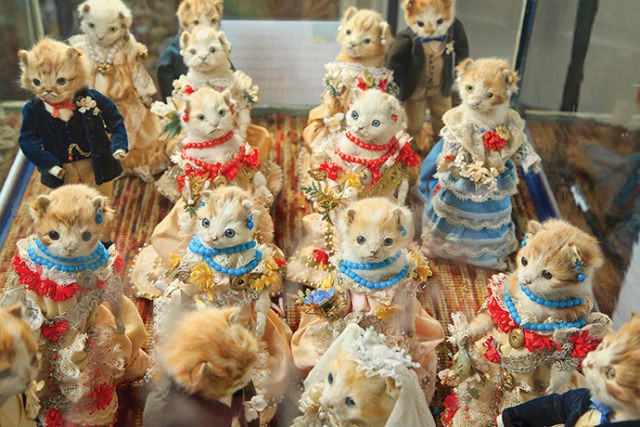

In 2003, while studying fashion design at Pratt, Divya Anantharaman did a database search for “Beatrix Potter.” The results brought back Walter Potter instead. (The Peter Rabbit author and the taxidermist were contemporaries, but not related). Years later she recalled, in a blog post , “I saw humanity — all that is humorous, frightening, and something in between.”
A few weeks after Katie’s rat class, I met Divya at a diner in Fort Greene. A close friend of Joanna, she teaches the other half of Morbid Anatomy’s taxidermy classes. While Katie favors bigger projects like deer and foxes, Divya loses herself in minute details: “I love how tedious it is to scoop meat out of a bird’s wing. It’s meditative.” Her pearl-studded fancy pigeons and flower-wreathed antler mounts attract a lot of attention on the internet.
Potter inspired Divya to pick up taxidermy as a hobby, and eventually abandon a career in fashion. Attracted to the way ivy creeps over an abandoned building, she analogizes, “Death moves over things — ultimately, you can’t prevent it.” To a taxidermist, this acknowledgement is thrilling: Divya is never going to run out of material for her art. As a Rogue, she works with the deformed, injured, and old, embellishing bald spots, birth defects, and tire marks with materials like fake crystals and real flowers, which she preserves at peak-bloom vibrancy with glycerin injections. (“That’s one of my few secrets.”) The contradiction is mesmerizing.
One of Divya’s most recent projects is a baby lamb: Covered in pearls, it hangs from the ceiling by a pink, polka-dotted ribbon looped around its belly. Below it, a cloud of pink tissue paper and tulle evokes piñatas and tutus, which, Divya explains, emphasize how young the lamb was when it died. As Divya puts it, “Everything dies.” But, “That’s just a way to celebrate life! You know, to realize the sanctity of it all.”
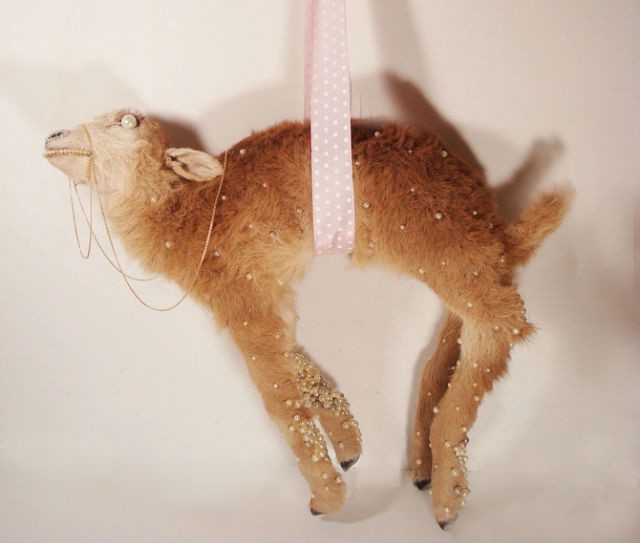

On a Monday night in February Joanna squeezed me in after a full day of meetings about fundraising. Compared to Katie and Divya, Joanna is unassuming — with shoulder-length blond hair and round glasses, she’s more children’s librarian than Oddities case study.
The Morbid Anatomy Library felt like a moodily-lit walk-in closet. I asked about a collection of what looked like wax ears, displayed in a glass case on pins like a butterfly collection. It turned to be a collection of tiny models of developing human embryos, purchased at a flea market. Sitting across from me at the wooden worktable that takes up most of the room’s walking space, Joanna pointed around. “There’s the wax moulage with a skin disease I made in London. That skeleton was donated by a friend of a friend, and the two-headed duckling is from my father.” It’s hard to imagine inching around the library clockwise without missing something.
Which is just how Joanna likes it. When it comes to established museums, she wants their respect, but not their curatorial standards. “Museums are like icebergs,” she explains. “Ten percent of the collection is on display at any given time, and 90 percent is backstage.” Her five-year plan is to showcase not just private collections on loan from quirky collectors with left-field interests, but “the pieces from public collections that would never be shown otherwise.”
Joanna studied intellectual history at Santa Cruz where, she says, she “read objects as texts.” Since college, her goal has been to understand “the ways in which human beings have changed, so that certain objects now seem bizarre to us, even though they weren’t at their conception.” When I asked for an example, Joanna introduced me to “the centerpiece of all of my research” — a framed photograph on the wall behind us that depicts Italian sculptor Clemente Susini’s Anatomical Venus, constructed around 1790 at La Specola, a wax workshop and museum in Florence. The naked female body, a life-sized prop for anatomy lessons, is made of wax. Her organs are nestled in a hollow stomach.
The Venus lies in a glass and rosewood case, a display typical of Catholic saints at the time (although religious likenesses were always clothed). Susini’s sculpture represents a blurry situation: for so long, representations of death had been in religion’s wheelhouse. Now, scientific representations were becoming more common. The Venus is the product of a brief time when “the torch, being passed from the Church to science, lingered in both hands.”
She was a hit, drawing audiences all over Europe. For Joanna, she is a constant reminder that “we’re living in the only time and place where death has become so demonized.”
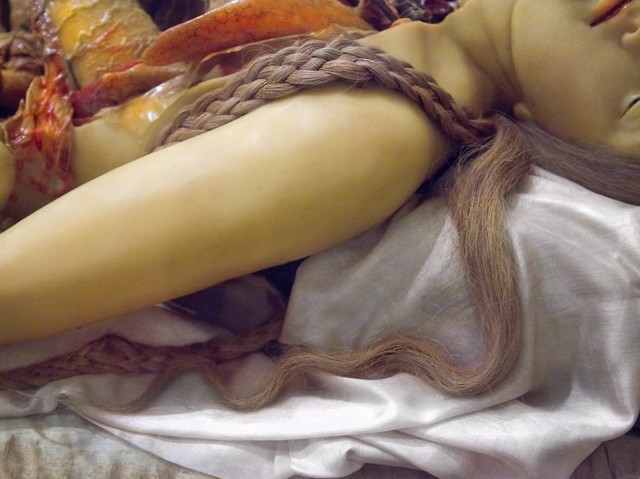
Joanna’s hope for the Morbid Anatomy Museum, when it opens this June, is to give visitors the opportunity to time travel — to appreciate oddities stripped of their oddness, as they might have been appreciated at the time of their inception. To this end, the inaugural exhibition of Walter Potter tableaux couldn’t be more fitting. But the museum will be also be a bigger, more accommodating classroom for Divya and Katie. Their attitude towards death, manifested through taxidermy, is contemporary and contagious.
Even though Joanna doesn’t do taxidermy herself, she gets it: “When I started collecting, I found myself saying out loud, ‘This really adds some life to the room!’ I can see how that might sound crazy. After all, these things are dead. But over the years I’ve realized that objects can flicker on edges — repulsive and attractive, spiritual and clinical, dead and alive. I am definitely attracted to that flickering.”
Check out the Morbid Anatomy Museum Kickstarter here. This Friday, they’re hosting a big fundraising party at Proteus Gowanus.
Emma Whitford is an editorial assistant at New York magazine. She also enjoys reviewing fiction for Publishers Weekly. She is, deeply, a New Englander.
